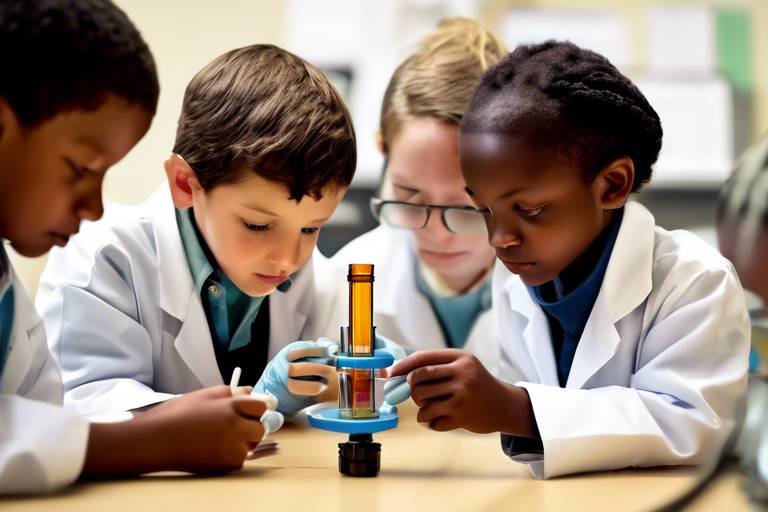Exploring the Science of Learning and Education Technologies
This article delves into the intersection of cognitive science and educational technology, examining how innovative tools enhance learning experiences and outcomes in various educational settings. In a world where information is at our fingertips, understanding how we learn and how technology can aid that process is more important than ever. Imagine walking into a classroom where every student is engaged, motivated, and thriving—this is the promise of merging learning science with cutting-edge technology.
Understanding the principles of learning science is crucial for developing effective educational strategies. At its core, learning science is about understanding how people absorb, process, and retain information. Key theories such as constructivism emphasize that learners build their own understanding through experiences. Meanwhile, cognitive load theory suggests that the amount of information presented at one time can significantly impact learning outcomes. This means that educators must carefully consider how they present information to avoid overwhelming students.
Education technologies have transformed traditional learning environments. From interactive whiteboards to online courses, technology has reshaped how educators deliver content and how students engage with it. Tools like learning management systems (LMS) allow for a centralized platform where students can access resources, submit assignments, and collaborate with peers. This shift not only enhances accessibility but also fosters an environment where learning can occur anytime and anywhere.
Digital learning environments offer interactive and flexible options for students. These platforms can provide personalized learning experiences that cater to individual needs. However, the transition to online learning is not without its challenges. Students may face issues like lack of motivation or difficulty in managing their time effectively. A study found that 75% of students reported feeling more engaged in interactive digital environments compared to traditional classrooms. This statistic highlights the potential of technology to enhance student engagement.
Gamification employs game-like elements to enhance learning experiences. By incorporating elements such as points, badges, and leaderboards, educators can motivate students to complete tasks and engage with the material more deeply. Imagine a classroom where students are racing to complete their assignments, not out of pressure, but for the thrill of earning rewards. This playful competition can significantly improve knowledge retention and make learning fun.
Adaptive learning technologies personalize education based on individual student needs. These systems analyze performance data to tailor learning experiences effectively. For example, if a student struggles with a particular concept, the system can provide additional resources or adjust the difficulty level of subsequent tasks. This personalized approach ensures that each learner progresses at their own pace, ultimately leading to better educational outcomes.
Collaborative learning encourages students to work together to solve problems and share knowledge. This strategy not only enhances critical thinking but also improves communication skills. In a world increasingly focused on teamwork, the ability to collaborate effectively is more important than ever. Students learn to value diverse perspectives and develop a sense of community, which is essential for their future careers.
The landscape of educational technology is constantly evolving. Emerging trends, such as artificial intelligence and immersive technologies, are likely to shape the future of learning. These tools not only enhance the educational experience but also prepare students for a tech-driven world.
Artificial intelligence is revolutionizing how educators approach personalized learning. AI can analyze vast amounts of data to identify learning patterns and adapt content accordingly. Imagine a tutor that understands your strengths and weaknesses better than you do! This level of personalization can significantly enhance student outcomes, making learning more efficient and enjoyable.
Virtual and augmented reality technologies provide immersive learning experiences. These tools allow students to explore complex subjects in a way that traditional methods cannot. For instance, a student studying biology can take a virtual tour of the human body, observing organs and systems in real-time. This hands-on experience can enhance understanding and retention, making learning both impactful and memorable.
- What is learning science? Learning science is the study of how people learn, focusing on cognitive processes and educational practices.
- How does technology enhance learning? Technology provides interactive, accessible, and personalized learning experiences, making education more engaging.
- What are the benefits of gamification? Gamification increases motivation, engagement, and knowledge retention by incorporating game-like elements into learning.
- What is adaptive learning technology? Adaptive learning technology personalizes education by adjusting content based on individual student performance.
- How does AI impact education? AI analyzes learning data to provide personalized educational experiences, improving student outcomes.

The Foundations of Learning Science
Understanding the principles of learning science is crucial for developing effective educational strategies. At its core, learning science is a multidisciplinary field that draws from psychology, neuroscience, and education to uncover how people acquire, retain, and apply knowledge. It's like piecing together a puzzle where each theory contributes to a clearer picture of the learning process. For instance, cognitive load theory suggests that our brains have a limited capacity for processing information at any given time. When we overload this capacity, learning becomes ineffective. Imagine trying to juggle too many balls at once; eventually, something is bound to drop!
Another foundational concept is constructivism, which posits that learners construct knowledge through experiences and reflection. This theory emphasizes the importance of engaging students in active learning, where they can explore, experiment, and collaborate. Think of it as building a sandcastle; the more you get your hands in the sand, the better your castle will turn out. This approach encourages educators to create environments where students can actively participate in their learning journey.
Furthermore, the social learning theory highlights the role of observation and imitation in learning. According to this theory, individuals learn not just through direct experience but also by watching others. This is why group work and peer interactions are so effective in educational settings. When students see their classmates tackle a problem or explain a concept, they’re more likely to engage with the material themselves. It's like watching a cooking show; you pick up tips and tricks just by observing the chef at work!
Research in learning science has also uncovered the significance of metacognition, or "thinking about thinking." This concept encourages students to be aware of their own learning processes, helping them to identify what strategies work best for them. For example, when students reflect on their study habits and adjust them accordingly, they become more effective learners. Imagine navigating through a maze; the more you understand the layout, the better you can find your way out.
To summarize, the foundations of learning science are built on several key theories and principles that inform effective teaching practices. Here’s a quick overview:
| Theory | Key Idea |
|---|---|
| Cognitive Load Theory | Learning is hindered when cognitive capacity is overloaded. |
| Constructivism | Knowledge is constructed through experiences and active engagement. |
| Social Learning Theory | Learning occurs through observation and imitation of others. |
| Metacognition | Awareness of one's own learning processes enhances effectiveness. |
As we continue to explore the intersection of cognitive science and educational technology, it becomes evident that understanding these foundational principles is essential for anyone involved in education. Whether you’re a teacher, a student, or a parent, grasping these concepts can significantly enhance the learning experience. By leveraging the insights from learning science, we can create educational environments that are not only more effective but also more engaging and enjoyable for everyone involved.

Technology's Role in Education
In today's fast-paced world, technology plays a pivotal role in shaping the educational landscape. Gone are the days when learning was confined to dusty textbooks and rigid classroom structures. Now, with just a click, students can access a wealth of information and resources that cater to their unique learning styles. But what does this mean for educators and learners alike? Let’s dive into how technology is transforming education and why it’s essential for both students and teachers to embrace these changes.
One of the most significant advancements in education technology is the rise of digital learning platforms. These platforms have revolutionized the way knowledge is disseminated and consumed. Imagine a classroom where students can learn at their own pace, revisiting challenging concepts through interactive videos, quizzes, and forums. This flexibility not only enhances understanding but also fosters a sense of autonomy among learners. With tools like Google Classroom and Moodle, educators can create a dynamic learning environment that extends beyond the traditional classroom walls.
Moreover, technology facilitates collaborative learning. Students can now connect with peers from around the globe, sharing ideas and resources effortlessly. This collaboration can take many forms, from group projects on platforms like Microsoft Teams to peer-reviewed discussions in online forums. By working together, students develop essential skills such as communication and critical thinking, which are crucial in today’s interconnected world.
However, it's important to recognize that integrating technology into education isn't without its challenges. Teachers must adapt to new tools and methodologies, which can be daunting. Additionally, there’s a risk of over-reliance on technology, potentially leading to disengagement or a lack of foundational skills. To mitigate these issues, educators must strike a balance between traditional teaching methods and modern technological tools. This balance ensures that students benefit from the best of both worlds.
In summary, technology's role in education is both transformative and essential. It opens up new avenues for learning, fosters collaboration, and prepares students for the future. As educators continue to innovate and adapt, the possibilities for enhancing educational experiences are endless. So, are you ready to embrace the change and harness the power of technology in your learning journey?
- How does technology improve student engagement? Technology offers interactive and personalized learning experiences that capture students' attention and motivate them to participate actively.
- What are some effective educational technologies? Some popular tools include online learning platforms like Coursera, collaboration tools like Slack, and adaptive learning technologies like Knewton.
- Can technology replace traditional teaching methods? While technology can enhance education, it should complement traditional methods rather than replace them entirely. A blended approach often yields the best results.
- What skills do students develop through technology use? Students develop critical thinking, problem-solving, collaboration, and digital literacy skills, all of which are essential in the modern workforce.

Digital Learning Environments
In today’s fast-paced world, have emerged as a revolutionary approach to education. These platforms are not just tools; they are dynamic ecosystems that facilitate learning in ways that traditional classrooms often cannot. Imagine a classroom where the walls are not barriers but gateways to a world of knowledge. This is what digital learning environments offer—flexibility, accessibility, and interactivity that empower students to take charge of their learning journey.
One of the most significant advantages of digital learning environments is their ability to cater to diverse learning styles. Whether you are a visual learner who thrives on videos and graphics, an auditory learner who benefits from podcasts and discussions, or a kinesthetic learner who needs hands-on activities, these platforms can provide customized experiences that traditional settings struggle to offer. For instance, students can engage with interactive simulations that bring complex concepts to life, allowing them to experiment and explore without the fear of making mistakes in a high-stakes environment.
However, it’s essential to acknowledge that the transition to digital learning is not without its challenges. While these environments offer numerous benefits, they can also lead to feelings of isolation among students. The lack of face-to-face interaction can sometimes hinder the development of social skills and collaborative learning experiences. To combat this, many platforms are incorporating social features that allow for peer interaction, discussion forums, and group projects, ensuring that students don’t miss out on the valuable exchanges that occur in traditional classrooms.
Another critical aspect of digital learning environments is the role of technology in facilitating personalized education. With the help of data analytics, educators can track student progress and identify areas where individuals may be struggling. This data-driven approach allows for timely interventions and tailored resources that meet each student’s unique needs. For example, if a student is having difficulty grasping a particular concept, educators can provide additional resources or alternative explanations to help them succeed.
Moreover, the integration of gamification elements in digital learning environments can significantly enhance student engagement. By incorporating game-like features such as points, badges, and leaderboards, educators can motivate students to participate actively in their learning. This not only makes learning more enjoyable but also fosters a sense of accomplishment and competition that can drive students to excel.
To summarize, digital learning environments represent a significant shift in how education is delivered. They offer a plethora of opportunities for personalized, engaging, and interactive learning experiences. Yet, as we embrace these technologies, it is crucial to remain mindful of the potential downsides and strive to create a balanced approach that combines the best of both digital and traditional educational methods. As we look to the future, the question remains: how can we continue to innovate and improve these environments to ensure that every student has the opportunity to thrive?
- What are digital learning environments?
Digital learning environments are online platforms that facilitate learning through interactive and flexible tools, allowing students to access educational resources anytime, anywhere. - How do digital learning environments cater to different learning styles?
These platforms utilize various multimedia resources, such as videos, podcasts, and interactive simulations, to accommodate visual, auditory, and kinesthetic learners. - What are the challenges of digital learning environments?
Some challenges include feelings of isolation among students and the potential for decreased social interaction, which can impact collaboration skills. - How can educators personalize learning in digital environments?
By using data analytics, educators can track student progress and tailor resources to meet individual learning needs effectively. - What role does gamification play in digital learning?
Gamification incorporates game-like elements to motivate students, making learning more engaging and enjoyable while fostering a sense of achievement.

Gamification in Education
Gamification in education is more than just a buzzword; it's a transformative approach that leverages game-like elements to create engaging learning experiences. Imagine walking into a classroom where students are not merely passive recipients of information but active participants in their learning journey. With gamification, educators can turn mundane lessons into exciting challenges that captivate students' attention and inspire them to learn. By integrating elements such as points, badges, and leaderboards, teachers can foster a sense of competition and achievement, making learning feel like a game rather than a chore.
One of the most compelling aspects of gamification is its ability to motivate students. When learners are rewarded for their efforts, whether through virtual badges or points accumulated for completing tasks, they are more likely to stay engaged and invested in their education. This is particularly important in a world where distractions are just a click away. By incorporating game mechanics, educators can create a dynamic learning environment that encourages students to push their boundaries and explore new concepts.
Moreover, gamification can significantly improve knowledge retention. When students interact with content in a playful and engaging manner, they are more likely to remember what they've learned. Studies have shown that gamified learning environments can lead to better outcomes, as students are not just memorizing facts but are instead applying their knowledge in practical scenarios. For instance, consider a history lesson where students earn points for completing quizzes or participating in discussions. This active involvement helps solidify their understanding and makes the learning experience more memorable.
However, it's essential to note that while gamification can be highly effective, it should be implemented thoughtfully. Not all students are motivated by the same rewards, and what works for one group may not resonate with another. Therefore, educators need to tailor gamification strategies to fit the unique dynamics of their classrooms. This could involve conducting surveys to understand student preferences or experimenting with different game mechanics to see what resonates best.
In addition to motivation and retention, gamification also encourages collaboration among students. Many gamified platforms allow learners to team up, fostering a sense of community and teamwork. When students work together to solve problems or achieve common goals, they develop essential skills such as critical thinking, communication, and empathy. It's like playing a multiplayer game where success depends on collaboration and strategy, which mirrors real-world scenarios they will face outside the classroom.
In conclusion, gamification in education is a powerful tool that can enhance learning experiences by making them more interactive, engaging, and rewarding. As we continue to explore innovative educational practices, it’s clear that incorporating game mechanics can lead to significant improvements in student motivation, retention, and collaboration. So, why not embrace this exciting approach and see how it can transform your classroom into a vibrant learning playground?
- What is gamification in education? - Gamification in education refers to the use of game-like elements in learning environments to enhance student engagement and motivation.
- How does gamification improve learning outcomes? - It improves learning outcomes by making lessons more interactive, increasing motivation, and enhancing knowledge retention through active participation.
- Can gamification be applied to all subjects? - Yes, gamification can be adapted to various subjects by tailoring game mechanics to fit the content and learning objectives.
- What are some examples of gamification in the classroom? - Examples include using points and badges for completing assignments, creating competitive quizzes, and developing collaborative group projects with game elements.

Adaptive Learning Technologies
Adaptive learning technologies have emerged as a revolutionary approach in the educational landscape, fundamentally changing how students interact with content. Imagine a classroom where each student receives a personalized learning experience tailored specifically to their strengths and weaknesses. This is not just a dream; it's the reality brought forth by adaptive learning systems. These technologies analyze a student's performance in real-time, adjusting the difficulty of tasks and the pace of instruction to match their unique learning needs. By doing so, they create a dynamic educational environment that fosters growth and engagement.
At the heart of adaptive learning is the use of sophisticated algorithms that track a student's progress and learning patterns. These algorithms collect data on various metrics, such as quiz scores, time spent on tasks, and even engagement levels during lessons. Based on this data, the system can identify areas where a student may be struggling and offer targeted resources or modify the curriculum to better suit their learning style. For instance, if a student excels in mathematics but struggles with reading comprehension, the adaptive learning platform can provide additional reading exercises while allowing the student to progress at their own pace in math.
One of the key benefits of adaptive learning technologies is their ability to provide immediate feedback. Traditional educational methods often involve delayed responses, where students may wait days or even weeks to understand their performance. In contrast, adaptive systems deliver instant feedback, enabling students to recognize their mistakes and learn from them right away. This immediate reinforcement not only boosts confidence but also encourages a growth mindset, where students are motivated to improve rather than feel defeated by challenges.
Moreover, adaptive learning technologies can cater to various learning styles. Some students are visual learners, while others may benefit from auditory or kinesthetic approaches. By offering diverse resources such as videos, interactive simulations, and hands-on activities, these systems ensure that every student can engage with the material in a way that resonates with them. This personalized approach can lead to higher retention rates and better overall academic performance.
However, the implementation of adaptive learning technologies is not without its challenges. Schools and educational institutions must invest in the necessary infrastructure, training, and resources to effectively integrate these systems into their curricula. Additionally, there are concerns about data privacy and the ethical implications of using student data to inform educational practices. As we move forward, it is essential for educators, policymakers, and technology developers to collaborate and address these issues to maximize the benefits of adaptive learning.
In conclusion, adaptive learning technologies represent a significant advancement in education, offering tailored experiences that cater to individual student needs. By leveraging data and technology, these systems not only enhance learning outcomes but also empower students to take charge of their education. As we continue to explore the potential of these innovative tools, the future of learning looks brighter than ever.
- What are adaptive learning technologies?
Adaptive learning technologies are systems that personalize educational content and experiences based on individual student performance and learning styles. - How do adaptive learning systems work?
These systems use algorithms to analyze student data, adjusting the difficulty and type of content presented to meet the learner's needs. - What are the benefits of using adaptive learning?
Benefits include personalized learning experiences, immediate feedback, and the ability to cater to various learning styles, leading to improved engagement and retention. - Are there any challenges associated with adaptive learning?
Challenges include the need for proper infrastructure, concerns about data privacy, and the requirement for teacher training to effectively implement these systems.

Collaborative Learning Strategies
In today's fast-paced educational landscape, collaborative learning has emerged as a dynamic approach that not only fosters knowledge acquisition but also enhances essential life skills. Imagine a classroom where students are not just passive recipients of information but active participants in their own learning journey. This method encourages learners to work together, share insights, and tackle challenges collectively, transforming the educational experience into something far more engaging and effective.
At the heart of collaborative learning lies the idea that teamwork can significantly enhance critical thinking and communication skills. When students collaborate, they are exposed to diverse perspectives, which can deepen their understanding of complex subjects. For instance, consider a group project where students must research a historical event. Through discussion and debate, they not only learn about the event itself but also develop their ability to articulate ideas, listen to others, and negotiate differences. This process is akin to a well-conducted orchestra, where each musician contributes to a harmonious outcome.
However, implementing collaborative learning strategies effectively requires careful planning and consideration. Educators need to create an environment that promotes trust and respect among students. This can be achieved by establishing clear guidelines and expectations for group work, ensuring that every member feels valued and accountable. Moreover, teachers should provide structured activities that encourage participation, such as:
- Group discussions that promote open dialogue.
- Peer teaching opportunities where students explain concepts to one another.
- Project-based learning that requires teamwork to solve real-world problems.
One of the most significant benefits of collaborative learning is its ability to prepare students for the real world. In today's job market, employers increasingly seek individuals who can work well in teams and communicate effectively. By engaging in collaborative projects, students not only build a robust knowledge base but also develop the soft skills that are critical for success in any career. It's like training for a marathon; the more you practice running with others, the better prepared you are for the race ahead.
Moreover, technology plays a pivotal role in facilitating collaborative learning. With tools like Google Classroom, Microsoft Teams, and various online forums, students can collaborate seamlessly, even from different locations. These platforms enable real-time communication and file sharing, making it easier for teams to coordinate their efforts. However, it is essential to strike a balance between technology and face-to-face interaction, as personal connections can significantly enhance the collaborative experience.
In conclusion, the power of collaborative learning strategies lies in their ability to foster a sense of community among students while enhancing their academic and interpersonal skills. As we continue to explore innovative educational practices, it's clear that collaboration is not just a trend; it's a fundamental aspect of effective learning that prepares students for future challenges. So, the next time you find yourself in a group project, remember that you are not just learning; you are building the skills that will serve you well beyond the classroom.
Q1: What is collaborative learning?
A: Collaborative learning is an educational approach where students work together in groups to solve problems, share knowledge, and learn from one another.
Q2: How does collaborative learning benefit students?
A: It enhances critical thinking, communication skills, and teamwork, preparing students for real-world challenges.
Q3: What tools can facilitate collaborative learning?
A: Online platforms like Google Classroom, Microsoft Teams, and various collaborative software can help students work together effectively, even from different locations.

Future Trends in Educational Technology
As we look ahead, the landscape of educational technology is not just evolving; it's undergoing a revolution. The fusion of innovative technologies with traditional educational practices is creating a dynamic learning environment that is more engaging and personalized than ever before. Imagine a classroom where every student's unique learning style is catered to, where information is not just delivered but experienced. This is the future we are heading towards, and it’s filled with exciting possibilities.
One of the most significant trends shaping the future of education is the integration of artificial intelligence (AI). AI is not just a buzzword; it's becoming a powerful tool that can analyze student data and adapt learning experiences to meet individual needs. For instance, AI-driven platforms can assess a student’s strengths and weaknesses, providing tailored resources that help them master difficult concepts. This personalized approach can significantly enhance student outcomes, making learning more efficient and effective.
Furthermore, the emergence of virtual reality (VR) and augmented reality (AR) technologies is transforming how students interact with content. These immersive tools allow learners to step into a 3D world where they can explore historical events, conduct virtual science experiments, or even practice language skills in a simulated environment. Imagine studying the solar system by actually "visiting" planets or learning about ancient civilizations by walking through their streets. This level of engagement not only makes learning fun but also deepens understanding and retention.
To give you a clearer picture, here’s a comparison of traditional learning methods versus these futuristic technologies:
| Aspect | Traditional Learning | Future Learning Technologies |
|---|---|---|
| Engagement | Passive listening | Active participation through VR/AR |
| Personalization | One-size-fits-all | Customized learning paths with AI |
| Accessibility | Limited to classroom | Available anytime, anywhere via digital platforms |
| Collaboration | Individual assignments | Group projects and discussions through online forums |
Moreover, we can't overlook the rise of collaborative learning strategies. As students increasingly work together on projects, they develop crucial skills in teamwork and communication. Online platforms are facilitating this collaboration, allowing students from different backgrounds to come together, share knowledge, and solve problems. This not only enriches their learning experience but also prepares them for the collaborative nature of the modern workplace.
In summary, the future of educational technology is bright and filled with potential. As AI, VR, AR, and collaborative tools continue to evolve, they will redefine how we learn and teach. The possibilities are endless, and the only limit is our imagination. Are we ready to embrace these changes and create a more engaging, personalized, and effective learning environment for all?
- What is the role of AI in education? AI helps personalize the learning experience by analyzing student data and adapting resources to meet individual needs.
- How does VR enhance learning? VR immerses students in interactive environments, making complex subjects more engaging and easier to understand.
- What are collaborative learning strategies? These strategies encourage students to work together, enhancing their problem-solving and communication skills.
- What trends should we watch for in educational technology? Keep an eye on AI advancements, the growth of immersive technologies like VR/AR, and the increasing importance of collaborative learning.

Artificial Intelligence in Education
Artificial Intelligence (AI) is not just a buzzword; it's a powerful tool that's reshaping the educational landscape in ways we never thought possible. Imagine walking into a classroom where every student is engaged, learning at their own pace, and receiving personalized support tailored just for them. That's the magic of AI in education! It’s like having a personal tutor available 24/7, ready to assist each student based on their unique learning style and needs.
One of the most exciting aspects of AI in education is its ability to analyze vast amounts of data. By examining student performance, AI systems can identify patterns and trends that educators might miss. This data-driven approach allows teachers to intervene early when a student is struggling, ensuring that no one falls behind. For instance, if a student consistently struggles with math problems, AI can alert the teacher, who can then provide targeted resources or additional support. It’s like having a crystal ball that reveals a student's learning journey, allowing for timely interventions.
Moreover, AI can enhance the learning experience through intelligent tutoring systems. These systems adapt to a student's learning pace and style, offering customized exercises and feedback. Think of it as a tailored workout plan for your brain! Instead of a one-size-fits-all approach, students receive a curriculum that evolves alongside their progress. This not only boosts confidence but also fosters a love for learning, as students can explore subjects at their own pace without the pressure of keeping up with their peers.
Additionally, AI-powered tools can streamline administrative tasks for educators, giving them more time to focus on teaching. Tasks like grading assignments, tracking attendance, and managing schedules can be automated, reducing the burden on teachers. This shift can lead to a more engaged and motivated teaching staff, ultimately benefiting students.
However, it's essential to acknowledge the challenges that come with integrating AI into education. Issues such as data privacy, the digital divide, and the need for teacher training must be addressed to ensure that AI is used ethically and effectively. Schools need to implement robust policies to protect student data while also providing educators with the necessary training to leverage these technologies effectively.
In conclusion, the integration of AI in education is not just about technology; it's about creating a more personalized, engaging, and effective learning environment. As we continue to explore the possibilities of AI, we must also remain vigilant about the challenges it presents. By doing so, we can harness the full potential of artificial intelligence to enhance educational outcomes for all students.
- What is AI in education?
AI in education refers to the use of artificial intelligence technologies to enhance teaching and learning processes. It can personalize learning experiences, automate administrative tasks, and provide data-driven insights to educators. - How does AI personalize learning?
AI personalizes learning by analyzing individual student data and adapting the curriculum to meet their specific needs, learning styles, and pace. This ensures that each student receives the support they require to succeed. - What are the challenges of using AI in education?
Challenges include data privacy concerns, the digital divide between students with different access to technology, and the need for teacher training to effectively utilize AI tools. - Can AI replace teachers?
No, AI is not meant to replace teachers. Instead, it serves as a tool to support educators by providing insights, automating routine tasks, and enhancing the learning experience for students.

Virtual and Augmented Reality
Virtual and Augmented Reality (VR and AR) are not just buzzwords; they are transforming the way we approach learning in profound ways. Imagine stepping into a historical event, walking alongside dinosaurs, or even conducting a chemistry experiment in a 3D lab—all from the comfort of your classroom or home. These technologies create immersive experiences that traditional learning methods simply cannot match. With VR, students can explore complex concepts in a visual and interactive manner, while AR enhances the real world by overlaying digital information onto physical environments.
One of the most exciting aspects of VR and AR in education is their ability to cater to various learning styles. Some students are visual learners, while others grasp concepts better through hands-on experiences. By leveraging these technologies, educators can provide tailored learning experiences that engage all types of learners. For instance, in a biology class, students can use AR to visualize the human body, seeing organs and systems in action, which can significantly deepen their understanding.
However, the integration of VR and AR into educational settings isn't without its challenges. One major hurdle is the cost of technology. Schools must invest in not only the hardware but also the software and training necessary to make the most of these tools. Additionally, there is the question of accessibility. Not all students have equal access to the devices required for VR and AR experiences, which can create disparities in learning opportunities.
Despite these challenges, the potential benefits of VR and AR in education are immense. Research has shown that immersive learning experiences can lead to higher retention rates and improved engagement. For example, a study conducted by the University of Maryland found that students who participated in VR-based learning retained information significantly better than those who learned through traditional methods. This is largely due to the way immersive experiences stimulate multiple senses, creating a richer learning environment.
Moreover, VR and AR can foster collaboration among students. Many platforms allow multiple users to interact within the same virtual space, promoting teamwork and communication skills. Imagine a group of students working together in a virtual lab, conducting experiments and solving problems in real-time. This not only enhances their learning experience but also prepares them for the collaborative nature of the modern workplace.
As we look to the future, the integration of VR and AR in education is likely to expand. With advancements in technology and a growing understanding of their benefits, we can expect to see more schools adopting these tools. The potential for creating engaging and effective learning experiences is limitless. As educators and students alike embrace these innovations, we stand on the brink of a new era in education—one where the boundaries of the classroom are expanded, and learning becomes an adventure.
- What are the main differences between Virtual Reality and Augmented Reality?
Virtual Reality immerses users in a completely digital environment, while Augmented Reality overlays digital information onto the real world. - How can VR and AR improve student engagement?
These technologies provide interactive and immersive experiences that capture students' attention and cater to different learning styles. - What challenges do schools face when implementing VR and AR?
Cost, accessibility, and the need for training are significant challenges that schools must address when integrating these technologies. - Can VR and AR be used in all subjects?
Yes, these technologies can enhance learning in various subjects, including science, history, and even arts, by providing interactive experiences.
Frequently Asked Questions
- What is learning science?
Learning science is the study of how people learn, focusing on the cognitive processes involved in acquiring knowledge. It combines insights from psychology, neuroscience, and education to develop effective teaching strategies and tools.
- How does technology enhance education?
Technology enhances education by providing innovative tools that facilitate interactive learning experiences. From online courses to educational apps, these technologies make learning more accessible, engaging, and tailored to individual needs.
- What are digital learning environments?
Digital learning environments are online platforms that offer flexible and interactive educational experiences. They allow students to learn at their own pace, access resources anytime, and engage with peers and instructors through various digital means.
- What is gamification, and how does it work in education?
Gamification is the integration of game-like elements into educational settings to motivate students. By incorporating rewards, challenges, and competition, gamification enhances engagement and helps improve knowledge retention.
- What are adaptive learning technologies?
Adaptive learning technologies customize educational experiences based on individual student performance. These systems analyze data to adjust content and learning paths, ensuring that students receive the support they need to succeed.
- Why is collaborative learning important?
Collaborative learning fosters teamwork and communication skills by encouraging students to work together on problem-solving tasks. This approach not only enhances critical thinking but also builds social skills essential for future success.
- What future trends should we expect in educational technology?
Future trends in educational technology include the rise of artificial intelligence, which personalizes learning experiences, and the use of virtual and augmented reality, providing immersive learning opportunities that can deepen understanding and engagement.
- How is artificial intelligence used in education?
Artificial intelligence is used in education to analyze student data, personalize learning experiences, and provide real-time feedback. This technology can help educators identify areas where students may need additional support, enhancing overall outcomes.
- What benefits do virtual and augmented reality offer in learning?
Virtual and augmented reality provide immersive experiences that allow students to explore complex concepts in a hands-on way. These technologies can make learning more engaging and help students visualize information, leading to better understanding and retention.



















